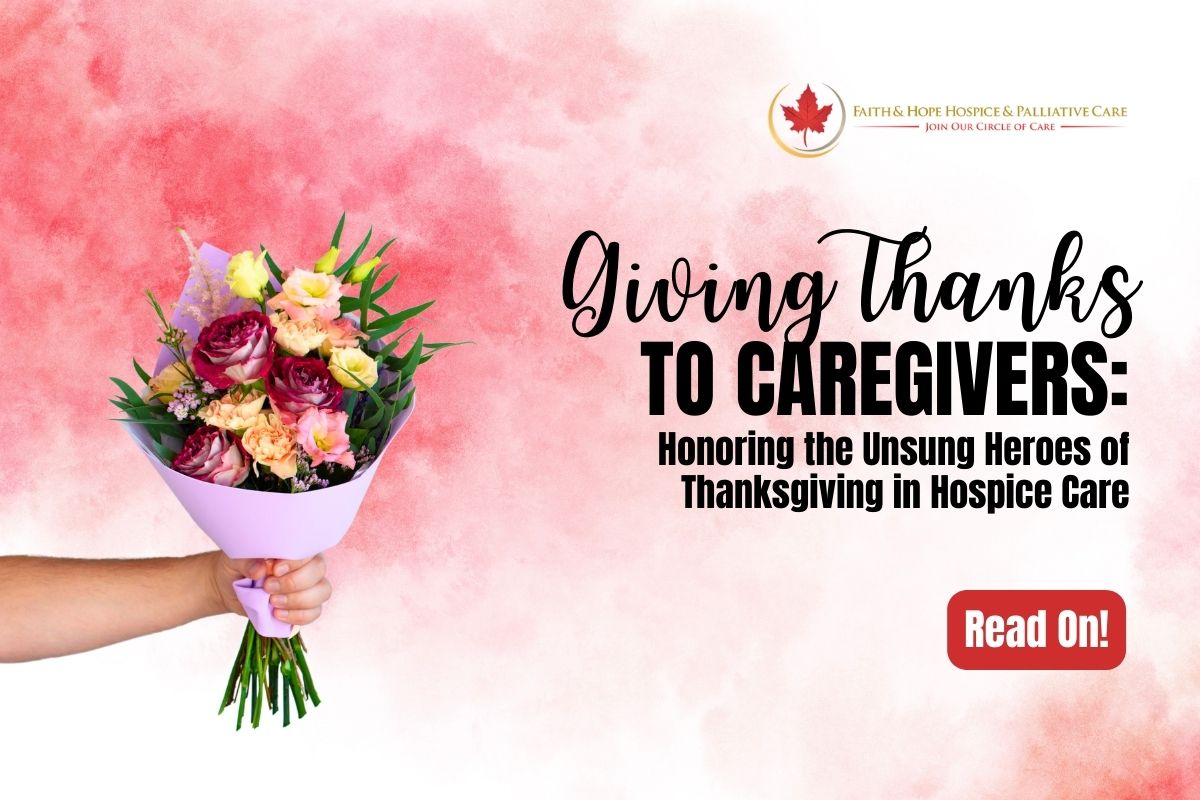
- By: administrator
- Blog
- No Comments
As Thanksgiving draws near, our focus turns to the unsung heroes of hospice care – the caregivers navigating the emotional and physical complexities of those facing terminal illnesses in Glendale and Los Angeles. In this exploration, we express gratitude for their invaluable contributions during the Thanksgiving season. We delve into the unique challenges and joys they encounter, shedding light on their selfless dedication, and offer essential tips for caregiver self-care.
The Heartfelt Dedication of Caregivers:
Caregivers in hospice care embody the essence of compassion and dedication. Their role extends beyond administering medical assistance; they are emotional pillars, providing solace and support to patients. Thanksgiving, with its emphasis on gratitude and connection, amplifies the significance of their work, making it an opportune time to recognize their tireless efforts.
Thanksgiving Season: A Special Chapter for Caregivers:
For caregivers, the Thanksgiving season represents a unique chapter in their caregiving journey. It is a time when their efforts to create a nurturing and festive atmosphere take center stage. The meticulous planning of special meals, the facilitation of activities that bring joy, and the overall commitment to infuse the holiday with warmth all contribute to making Thanksgiving in hospice care a distinctive and emotionally charged experience.

Expressing Gratitude: A Thanksgiving Tribute to Caregivers:
In the spirit of Thanksgiving, we extend our heartfelt gratitude to these unsung heroes. Their selflessness, empathy, and relentless dedication create a ripple effect of comfort and hope within the Los Angeles and Glendale hospice community. The blog explores the myriad ways in which caregivers contribute to the well-being of patients and families, emphasizing their role as beacons of compassion during a time that can be emotionally challenging.
Challenges Faced by Caregivers During Thanksgiving:
As caregivers in hospice care approach the Thanksgiving season, a unique set of challenges arises, demanding intricate navigation of emotional complexities. These challenges, while inherent to the caregiving role, take on a heightened significance during a time that is culturally and emotionally charged. Here, we explore the nuanced challenges caregivers encounter during Thanksgiving, recognizing the importance of acknowledging and addressing these emotional tolls for the sake of their own well-being.
1. Emotional Toll:
Thanksgiving magnifies the emotional demands of caregiving, amplifying the intensity of feelings as caregivers witness firsthand the impact of terminal illnesses on both patients and their families. The juxtaposition of a holiday centered around gratitude and togetherness with the stark reality of terminal illness can evoke a spectrum of emotions, from sorrow to gratitude, creating a delicate emotional landscape for caregivers to traverse.
Addressing the Emotional Challenges:
- Encourage caregivers to engage in open dialogue about their emotions, providing a safe space for them to express their feelings without judgment.
- Facilitate regular debriefing sessions, allowing caregivers to share their experiences and provide emotional support from peers or mental health professionals.
2. Grieving Alongside Families:
One of the profound aspects of caregiving is the deep connection formed between caregivers and patients and their families. During Thanksgiving, a time often associated with family gatherings and expressions of gratitude, the grief process for caregivers may intensify. They find themselves navigating their own emotions while supporting families who are experiencing their own unique challenges and losses.
As Glendale and Los Angeles hospice care professionals face the emotional complexities of Thanksgiving, it is crucial to acknowledge the multifaceted challenges they encounter. By recognizing the heightened emotional toll, assisting in balancing personal and professional roles, and addressing the nuances of grieving alongside families, the caregiving community can foster an environment of empathy, support, and resilience. This holistic approach not only benefits the well-being of caregivers but also contributes to the overall quality of care provided during this poignant season in the realm of hospice.
Tips for Caregiver Self-Care During Thanksgiving:
Los Angeles and Glendale hospice care professionals are the backbone of support for those facing terminal illnesses and their families. As Thanksgiving approaches, the emotional demands of the season can be particularly challenging for these caregivers. Recognizing the significance of self-care, here are practical tips aimed at nurturing the nurturers during this emotionally charged time:
1. Pause and Reflect: Acknowledging Emotions for Emotional Well-being
Encourage caregivers to set aside dedicated moments for self-reflection. The emotionally charged nature of Thanksgiving can evoke a range of feelings, and acknowledging these emotions is essential for maintaining emotional well-being. Reflection allows caregivers to understand their own reactions, process feelings, and find meaning in their caregiving journey.
Implementation Tips:
- Provide dedicated quiet spaces for reflection within the caregiving environment.
- Offer journaling prompts or guided meditation resources to facilitate self-reflection.
2. Seek Support: Recognizing Strength in Seeking Help
Remind caregivers that seeking support is a sign of strength, not weakness. The emotional challenges of caregiving can be alleviated through professional counseling, participation in support groups, and building connections within peer networks. Having outlets for expressing emotions and receiving guidance is crucial for preventing burnout and maintaining mental and emotional health.
Implementation Tips:
- Facilitate access to mental health professionals for individual or group counseling sessions.
- Establish a supportive network within the caregiving team for shared experiences and advice.
3. Create Boundaries: Balancing Professional and Personal Life
Establishing clear boundaries between work and personal life is crucial for caregivers. Encourage them to set realistic expectations for themselves and prioritize self-care to prevent burnout. The holiday season often blurs these lines, making it imperative for caregivers to define when they are in their caregiving role and when they are taking time for personal reflection and rejuvenation.
Implementation Tips:
- Provide training on setting and maintaining healthy boundaries.
- Encourage caregivers to communicate their boundaries to the caregiving team and families.
4. Celebrate Small Victories: Recognizing Personal Impact
Caregivers often dedicate themselves to the well-being of others, sometimes overlooking their own achievements. Encourage them to celebrate small victories, acknowledging the positive impact they make in the lives of their patients and families. Recognizing and celebrating these moments contributes to a sense of accomplishment and reinforces the value of their caregiving efforts.
Implementation Tips:
- Incorporate regular team check-ins to share and celebrate small victories.
- Establish a culture of appreciation within the caregiving environment.
5. Embrace Gratitude Practices: Cultivating Positivity
Incorporating gratitude practices into daily routines can positively impact caregivers’ mental and emotional well-being. From keeping a gratitude journal to actively seeking and acknowledging moments of joy, cultivating gratitude can serve as a powerful antidote to the emotional challenges of caregiving during Thanksgiving.
Implementation Tips:
- Provide resources on gratitude practices and their benefits.
- Encourage caregivers to share moments of gratitude during team meetings.
By implementing these tips, hospice care providers in Glendale and Los Angeles can foster a culture of care that prioritizes the well-being of caregivers. As Thanksgiving unfolds, let us recognize the profound dedication of those who nurture others and ensure that they, too, receive the support and self-care they need to navigate the emotional landscape of the season. In doing so, caregivers can continue to provide compassionate and resilient care, creating a positive impact on both their professional and personal lives.
Conclusion: A Thanksgiving Salute to Caregivers:
As Thanksgiving dawns, our gratitude extends to caregivers, the unsung heroes in hospice care in Glendale and Los Angeles. Recognizing their contributions goes beyond gratitude; it highlights the importance of caregiver self-care. May caregivers find moments of respite and appreciation, knowing that their acts of kindness echo far beyond the holiday season, creating a legacy of compassion and comfort.
